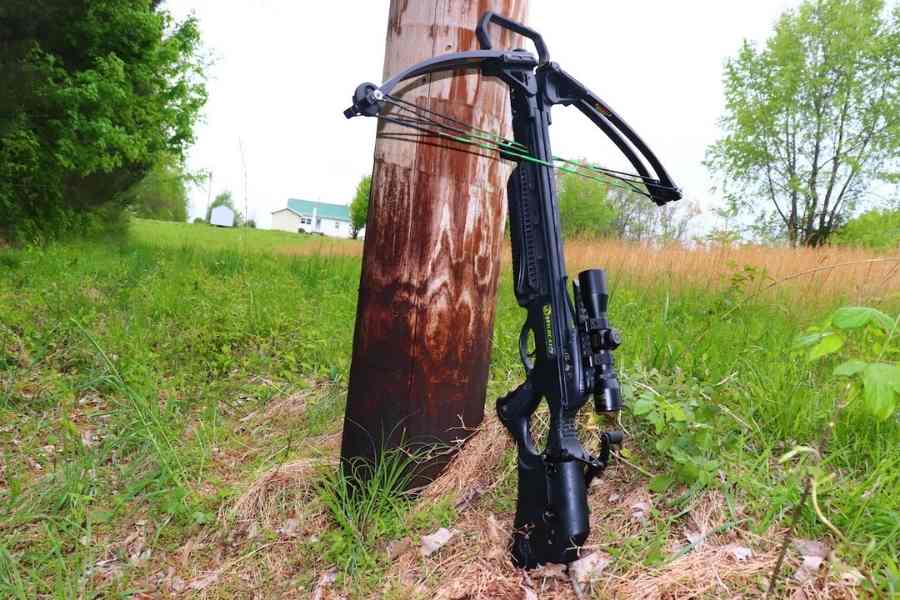The crossbow’s popularity has skyrocketed among hunters over the past couple of decades. This, of course, is for a good reason, as crossbows are quite effective at taking game of any size.
Additionally, many states now offer weapon-specific seasons, just for those intending to use a crossbow when heading afield.
This, in turn, has led to a significant increase in the number of crossbows sold in recent years and numerous questions from numerous perspective crossbow owners.
One of the most common questions centers around the draw weight required for a crossbow to cleanly and effectively harvest deer-sized game.
Contents (Jump to Topic)
ToggleHow Much Is Enough?
On an annual basis, many hunters find themselves questioning whether or not a particular crossbow is of enough poundage to harvest game of moderate to large size.
After all, a lack of adequate draw weight can lead to reduced penetration, rendering an otherwise ideal shot marginal at best.
Most states have now issued minimum poundage restrictions on crossbows intended for use while hunting.
While this minimum varies considerably from one state to the next, most figures fall within a general range of 75-125 pounds of draw.
read.. how to make your crossbow quieter
By all accounts, crossbows featuring draw weights within this range are adequate for harvesting a variety of game, including whitetail deer.
At this threshold, anticipated downrange kinetic energy is sufficient to provide ample penetration, thereby maximizing blood loss and causing quick expiration.
Below the 75-pound draw weight threshold, much of the same cannot be said. While crossbows of this type are largely restricted from use while hunting, they also lack enough power to provide consistent penetration at any respectable distance.
As a result, a crossbow of this type´s effectiveness when attempting to take game is significantly diminished.
More Is Better?
That which is discussed above also begs another question of sorts. When choosing a crossbow for use afield, is there any such thing as too much draw weight?
Generally speaking, when paired with a well-suited arrow or bolt, crossbows of a higher draw weight deliver greater downrange kinetic energy and provide enhanced penetration.
read.. how long to wait after shooting deer with a crossbow?
However, this does have its own limitations, as crossbows exceeding 200 pounds of draw weight are seldom used when hunting deer-sized game.
In fact, the state of Ohio has even issued a maximum draw weight restriction of 200 pounds for hunting crossbows as of late.
In almost every instance, it is recommended to select a crossbow that utilizes a heavier draw weight over that which is marginal in the same regard, if manageable by the particular hunter in question.
A variety of cocking aids are now offered, making it easier than ever for even the most petite of hunters to cock a heavier poundage crossbow without issue.
As of late, advanced pulley or crank-style cocking devices have risen to prominence, taking brute force out of the crossbow cocking equation.
One is now able to cock heavier crossbows without straining or pulling excessively upon the string itself. This has eliminated much in the way of hesitation toward the use of heavier poundage crossbows.
Finding a Happy Medium

From that which has been relayed above, we know that 75 pounds of draw weight serve as the approximate minimum for use in a hunting scenario, yet anything above 200 pounds of draw weight is largely excessive.
So is there any such thing as a ¨sweet spot¨, or happy medium when determining the perfect draw weight for hunting-related uses?
In truth, this middle ground has already been established for hunters by the bulk of reputable crossbow manufacturers. Most manufacturers offer the vast majority of their most popular hunting crossbows in draw weights of 125-175 pounds. This is due to the positive characteristics offered by a crossbow of such poundage.
Most crossbows within this poundage range fire even relatively heavy arrows or bolts at considerable speed, thus directing substantial amounts of kinetic energy downrange.
This results in frequent pass-throughs, stellar blood trails, and quick kills, all of which lead to a higher rate of game recovery.
Along the same lines, crossbows of this poundage also fire bolts or arrows with remarkable accuracy and stability, thereby leading to predictable arrow flight and enhanced accuracy.
At even higher speeds, a lack of flight consistency often arises, leaving much to be desired in terms of overall performance.
Additionally, even rigorously engineered crossbows tend to be subject to increased mechanical failure when operating at draw weights in excess of the industry standard.
Simply put, this excessive draw weight leads to increased stress and accelerated wear of virtually all mechanical components. This, in turn, can prove detrimental to a crossbow’s overall durability.
Why Is Heavier Poundage Required (Vs. Vertical Bows)?
Those new to crossbow use might find themselves wondering why a crossbow is required to fire at much higher draw weights than a vertical bow to achieve similar results.
After all, many deer have been killed throughout the years with compound bows shooting as little as 40-50 pounds of draw weight.
The answer to this question lies in the mechanics of the crossbow itself, as opposed to the standard vertical bow, whether of a traditional or compound configuration.
A crossbow’s shorter limbs yield a shorter power-stroke or range of motion in which energy is transferred to an arrow than a vertical bow.
For this reason, a crossbow’s limbs must be of much heavier construction, allowing them to deliver tremendous amounts of energy over this relatively short power-stroke.
This, in turn, necessitates much higher draw weights than would otherwise be required of a compound, recurve, or longbow.
These heavier limbs are also complimented by the use of rather aggressive cams, which waste no time when converting their stored rotational energy into mechanical force applied upon an arrow.
This results in amplified kinetic energy at most any range and faster overall arrow speeds. As a byproduct, penetration is also significantly increased.
The principle described above also accounts for a crossbow´s use of a heavier frame than that utilized by vertical bows.
Since the laws of science stipulate that every action has an equal and opposite reaction, a crossbow must be capable of absorbing and dissipating this heavier discharge of energy, as an arrow is ultimately released.
The Bottom Line
In summary, there is certainly a sweet spot when determining what poundage of crossbow to purchase for hunting-related uses. In almost every instance, this draw weight falls within a range of 75-125 pounds.
However, an archer can also get away with shooting crossbows of a lighter weight when deemed necessary, as long as this weight is sufficient enough to deliver a clean, ethical kill.
Under the bulk of circumstances, this minimum draw weight is at, or around, 75-80 pounds. However, it is also important to check with all applicable local or state agencies when determining the legal minimum crossbow draw weight in the specific area that you intend to hunt.
Failure to do so can result in the violation of one or more game laws and a penalty under law.






